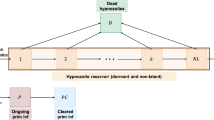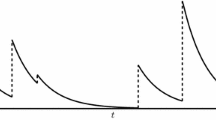Abstract
In this paper we focus on networks of infinite-server queues with nonhomogeneous Poisson arrival processes. We start by introducing a more general Poisson-arrival-location model (PALM) in which arrivals move independently through a general state space according to a location stochastic process after arriving according to a nonhomogeneous Poisson process. The usual open network of infinite-server queues, which is also known as a linear population process or a linear stochastic compartmental model, arises in the special case of a finite state space. The mathematical foundation is a Poisson-random-measure representation, which can be obtained by stochastic integration. It implies a time-dependent product-form result: For appropriate initial conditions, the queue lengths (numbers of customers in disjoint subsets of the state space) at any time are independent Poisson random variables. Even though there is no dependence among the queue lengths at each time, there is important dependence among the queue lengths at different times. We show that the joint distribution is multivariate Poisson, and calculate the covariances. A unified framework for constructing stochastic processes of interest is provided by stochastically integrating various functionals of the location process with respect to the Poisson arrival process. We use this approach to study the flows in the queueing network; e.g., we show that the aggregate arrival and departure processes at a given queue (to and from other queues as well as outside the network) are generalized Poisson processes (without necessarily having a rate or unit jumps) if and only if no customer can visit that queue more than once. We also characterize the aggregate arrival and departure processes when customers can visit the queues more frequently. In addition to obtaining structural results, we use the stochastic integrals to obtain explicit expressions for time-dependent means and covariances. We do this in two ways. First, we decompose the entire network into a superposition of independent networks with fixed deterministic routes. Second, we make Markov assumptions, initially for the evolution of the routes and finally for the entire location process. For Markov routing among the queues, the aggregate arrival rates are obtained as the solution to a system of input equations, which have a unique solution under appropriate qualifications, but not in general. Linear ordinary differential equations characterize the time-dependent means and covariances in the totally Markovian case.
Similar content being viewed by others
References
S. Asmussen and T. Rolski, Risk theory in a periodic environment: the Cramér-Lundberg approximation and Lundberg's inequality, Institute for Electronic Systems, University of Aaborg, Denmark (1991).
N. Bambos and J. Walrand, On queues with periodic inputs, J. Appl. Prob. 26 (1989) 381–389.
R.E. Barlow and F. Proschan,Statistical Theory of Reliability and Life Testing (Holt, Rinehart and Winston, New York, 1975).
M.S. Bartlett, Some evolutionary stochastic processes, J. Roy. Statist. Soc.B 11 (1949) 211–229.
P. Billingsley,Convergence of Probability Measures (Wiley, New York, 1968).
J.P.C. Blanc, The transient behavior of networks of infinite server nodes, Centre for Mathematics and Computer Science, Amsterdam, Report OS-R8408 (1984).
N. Bourbaki,Elements of Mathematics, General Topology, Part 2(Addison-Wesley, Reading, MA, 1966).
P. Brémaud,Point Processes and Queues (Springer, New York, 1981).
M. Brown, An invariance property of a Poisson process, J. Appl. Prob. 6 (1969) 453–458.
M. Brown and S.M. Ross, Some results for infinite server Poisson queues, J. Appl. Prob. 6 (1969) 604–611.
R.F. Brown, Compartmental system analysis, IEEE Trans. Biomed. Eng. BME-27 (1980) 1–11.
M.J. Carrillo, Extensions of Palm's theorem: A review, Manag. Sci. 37 (1991) 739–744.
C.L. Chiang,An Introduction to Stochastic Processes and their Applications (Krieger, Huntington, NY, 1980).
K.L. Chung,A Course in Probability Theory, 2nd ed. (Academic Press, New York, 1974).
T. Collings and C. Stoneman, TheM/M/∞ queue with varying arrival and departure rates, Oper. Res. 24 (1976) 760–773.
D.J. Daley, Queueing output processes, Adv. Appl. Prob. 8 (1976) 395–415.
D.J. Daley and D. Vere-Jones,An Introduction to the Theory of Point Processes (Springer, New York, 1988).
R.L. Disney and P.C. Kiessler,Traffic Processes in Queueing Networks, A Markov Renewal Approach (The Johns Hopkins University Press, Baltimore, 1987).
J.L. Doob,Stochastic Processes (Wiley, New York, 1953).
A. Duda, Diffusion approximations for time-dependent queueing systems, IEEE J. Sel. Areas Commun. SAC-4 (1986) 905–918.
S.G. Eick, W.A. Massey and W. Whitt, The physics of theM t /G/∞ queue, Oper. Res. 41 (1993), to appear.
S.G. Eick, W.A. Massey and W. Whitt,M t /G/∞ queues with sinusoidal arrival rates, Manag. Sci. 39 (1993) 241–252.
S.G. Eick, W.A. Massey and W. Whitt, Infinite-server approximations for multi-server loss models with time-dependent arrival rates, AT&T Bell Laboratories, Murray Hill, NJ, in preparation.
S.N. Ethier and T.G. Kurtz,Markov Processes, Characterization and Convergence (Wiley, New York, 1986).
M.J. Faddy, Stochastic compartmental models as approximations to more general stochastic systems with the general stochastic epidemic as an example, Adv. Appl. Prob. 9 (1977) 448–461.
R.D. Foley, The non-homogeneousM/G/∞ queue, Opsearch 19 (1982) 40–48.
M.R. Garzia and C.M. Lockhart, Nonhierarchical communications networks: an application of compartmental modeling, IEEE Trans. Commun. COM-37(1989) 555–564.
P.W. Glynn and W. Whitt, A new view of the heavy-traffic limit theorem for infinite-server queues, Adv. Appl. Prob. 23 (1991) 188–209.
L. Green, P. Kolesar and A. Svoronos, Some effects of nonstationarity on multiserver Markovian queueing systems, Oper. Res. 39 (1991) 502–511.
R.W. Hall,Queueing Methods for Services and Manufacturing (Prentice-Hall, Englewood Cliffs, NJ, 1991).
J.M. Harrison and A.J. Lemoine, A note on networks of infinite-server queues, J. Appl. Prob. 18 (1981) 561–567.
R.R.P. Jackson and P. Aspden, A transient solution to the multistage Poisson queueing system with infinite servers, Oper. Res. 28 (1980) 618–622.
J.A. Jacques,Compartmental Analysis in Biology and Medicine, 2nd ed. (University of Michigan Press, Ann Arbor, 1985).
D.L. Jagerman, Nonstationary blocking in telephone traffic, Bell Syst. Tech. J. 54 (1975) 625–661.
N.L. Johnson and S. Kotz,Discrete Distributions (Wiley, New York, 1969).
J. Keilson and L.D. Servi, Networks of non-homogeneousM/G/∞ systems, GTE Laboratories, Waltham, MA (1989).
F.P. Kelly,Reversibility and Stochastic Networks (Wiley, New York, 1979).
F.P. Kelly, Loss networks, Ann. Appl. Prob. 1 (1991) 319–378.
A.Y. Khintchine,Mathematical Methods in the Theory of Queueing (Trudy Mat. Inst. Steklov 49, in Russian (1955)). (English translation by Charles Griffin and Co., London, 1960).
J.F.C. Kingman, Markov population processes, J. Appl. Prob. 6 (1969) 1–18.
T.G. Kurtz,Approximation of Population Processes, CBMS-NSF Regional Conf. Series in Appl. Math. 36 (SIAM, Philadelphia, 1981).
A.J. Lemoine, Waiting time and workload in queues with periodic Poisson input, J. Appl. Prob. 26 (1989) 390–397.
W.C.Y. Lee,Mobile Cellular Telecommunications Systems (McGraw-Hill, New York, 1989).
P.A.W. Lewis and G.S. Shedler, Simulation of nonhomogeneous Poisson processes by thinning, Naval Res. Logist Quart. 29 (1979) 403–413.
W.A. Massey, Asymptotic analysis of the time dependentM/M/1 queue, Math. Oper. Res. 10 (1985) 305–327.
J.H. Matis, An introduction to stochastic compartmental models in pharmacokinetics, in:Pharmacokinetics, eds. A. Percele and A. Rescigno (Plenum, New York, 1988) pp. 113–128.
J.H. Matis and T.E. Wehrly, Generalized stochastic compartmental models with Erlang transit times, J. Pharmacokin. Biopharm. 18 (1990) 589–607.
N.M. Mirasol, The output of anM/G/∞ queueing system is Poisson, Oper. Res. 11 (1963) 282–284.
J. Neveu,Mathematical Foundations of the Calculus of Probability (Holden-Day, San Francisco, 1965).
G.F. Newell, TheM/G/∞ queue, SIAM J. Appl. Math. 14 (1966) 86–88.
G.F. Newell,Approximate Stochastic Behavior of n-Server Service Systems with Large n, Lecture Notes in Econ. and Math. Systems 87 (Springer, Berlin, 1973).
G.F. Newell,Applications of Queueing Theory (Chapman and Hall, London, 1982).
G.L. O'Brien, The comparison method for stochastic processes, Ann. Probab. 3 (1975) 80–88.
K.L. Ong and M.R. Taaffe, Nonstationary queues with interrupted Poisson arrivals and unreliable/repairable servers, Queueing Systems 4 (1989) 27–46.
A.G. Pakes and N. Kaplan, On the subcritical Bellman-Harris process with immigration, J. Appl. Prob. 11 (1974) 652–668.
C. Palm, Intensity variations in telephone traffic, Ericsson Technics 44 (1943) 1–189 (in German). (English translation by North-Holland, Amsterdam, 1988).
K.R. Parthasarathy,Probability Measures on Metric Spaces (Academic, New York, 1967).
A. Prékopa, On secondary processes generated by a random point distribution of Poisson type, Annales Univ. Sci. Budapest de Eötvös Nom. Sectio Math. 1 (1958) 153–170.
P. Purdue, Stochastic compartmental models: a review of the mathematical theory with ecological applications, in:Compartmental Analysis of Ecosystems Models, eds. J.H. Matis, B.C. Patten and G.C. White (International Co-operative Publishing House, Fairland, MD, 1979) pp. 223–260.
A. Renyi, Remarks on the Poisson process, Studia Sci. Math. Hungar. 2 (1967) 119–123.
T. Rolski, Queues with nonstationary inputs, Queueing Systems 5 (1989) 113–130.
H.L. Royden,Real Analysis, 2nd ed. (London, Macmillan, 1968).
I.W. Sandberg, On the mathematical foundations of compartmental analysis in biology, medicine and ecology, IEEE Trans. Circuit Syst. CAS-25 (1978) 273–279.
R.F. Serfozo, Point processes, in:Stochastic Models, eds. D.P. Heyman and M.J. Sobel(North-Holland, Amsterdam, 1990) pp. 1–93.
A.V. Skorokhod, Limit theorems for stochastic processes, Theor. Prob. Appl. 1 (1956) 261–290.
D. Stoyan,Comparison Methods for Queues and Other Stochastic Models (Wiley, New York, 1983).
H. Thorisson, On regenerative and ergodic properties of the k-server queue with nonstationary Poisson arrivals, J. Appl. Prob. 22 (1985) 893–902.
J. Walrand,An Introduction to Queueing Networks (Prentice-Hall, Englewood Cliffs, NJ, 1989).
D. Weiner and P. Purdue, A semi-Markov approach to stochastic compartmental models, Commun. Statist. A6 (1977) 1231–1243.
W. Whitt, Some useful functions for functional limit theorems, Math. Oper. Res. 5 (1980) 67–85.
W. Whitt, On the heavy-traffic limit theorem forGI/G/∞ queues, Adv. Appl. Prob. 14 (1982), 171–190.
P. Whittle,Systems in Stochastic Equilibrium (Wiley, New York, 1986).
J. Abate and W. Whitt, Transient behavior of theM/M/1 queue via Laplace transforms, Adv. Appl. Prob. 20 (1988) 145–178.
W. Whitt, Deciding which queue to join: some counterexamples, Oper. Res. 34 (1986) 55–62.
Author information
Authors and Affiliations
Rights and permissions
About this article
Cite this article
Massey, W.A., Whitt, W. Networks of infinite-server queues with nonstationary Poisson input. Queueing Syst 13, 183–250 (1993). https://doi.org/10.1007/BF01158933
Received:
Revised:
Issue Date:
DOI: https://doi.org/10.1007/BF01158933




